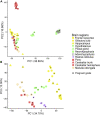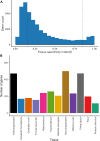A protein-coding gene expression atlas from the brain of pregnant and non-pregnant goats
- PMID: 37519888
- PMCID: PMC10382233
- DOI: 10.3389/fgene.2023.1114749
A protein-coding gene expression atlas from the brain of pregnant and non-pregnant goats
Abstract
Background: The brain is an extraordinarily complex organ with multiple anatomical structures involved in highly specialized functions related with behavior and physiological homeostasis. Our goal was to build an atlas of protein-coding gene expression in the goat brain by sequencing the transcriptomes of 12 brain regions in seven female Murciano-Granadina goats, from which three of them were 1-month pregnant. Results: Between 14,889 (cerebellar hemisphere) and 15,592 (pineal gland) protein-coding genes were expressed in goat brain regions, and most of them displayed ubiquitous or broad patterns of expression across tissues. Principal component analysis and hierarchical clustering based on the patterns of mRNA expression revealed that samples from certain brain regions tend to group according to their position in the anterior-posterior axis of the neural tube, i.e., hindbrain (pons and medulla oblongata), midbrain (rostral colliculus) and forebrain (frontal neocortex, olfactory bulb, hypothalamus, and hippocampus). Exceptions to this observation were cerebellum and glandular tissues (pineal gland and hypophysis), which showed highly divergent mRNA expression profiles. Differential expression analysis between pregnant and non-pregnant goats revealed moderate changes of mRNA expression in the frontal neocortex, hippocampus, adenohypophysis and pons, and very dramatic changes in the olfactory bulb. Many genes showing differential expression in this organ are related to olfactory function and behavior in humans. Conclusion: With the exception of cerebellum and glandular tissues, there is a relationship between the cellular origin of sampled regions along the anterior-posterior axis of the neural tube and their mRNA expression patterns in the goat adult brain. Gestation induces substantial changes in the mRNA expression of the olfactory bulb, a finding consistent with the key role of this anatomical structure on the development of maternal behavior.
Keywords: RNA-Seq; differential gene expression (DGE); embryonic vesicle; encephalon; gestation; goat.
Copyright © 2023 Luigi-Sierra, Guan, López-Béjar, Casas, Olvera-Maneu, Gardela, Palomo, Osuagwuh, Ohaneje, Mármol-Sánchez and Amills.
Conflict of interest statement
The authors declare that the research was conducted in the absence of any commercial or financial relationships that could be construed as a potential conflict of interest.
Figures




References
LinkOut - more resources
Full Text Sources

